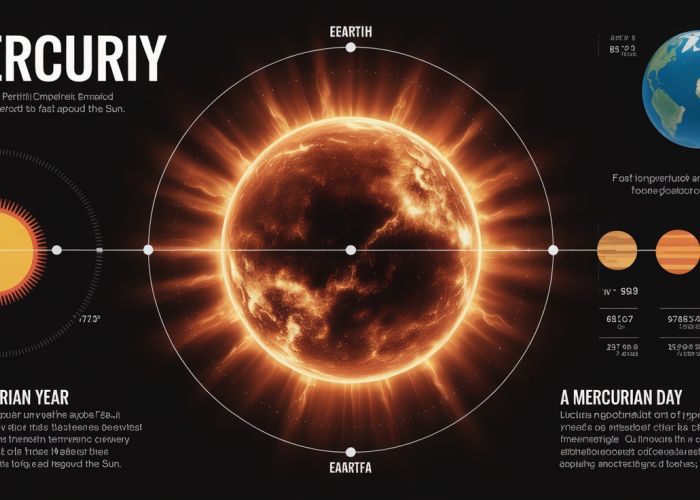The planet Mercury, a subject extensively studied by the BepiColombo mission, presents unique challenges for understanding planetary dynamics. Its elliptical orbit, a significant aspect of celestial mechanics, significantly influences the orbital period of Mercury. The study of Mercury’s orbit involves intricate calculations of its Keplerian elements, providing insights into its velocity and position. Understanding the complexities surrounding the orbital period of Mercury requires accurate models provided by the NASA Jet Propulsion Laboratory (JPL).

Unlock Mercury’s Secrets: Decoding Its Orbital Period!
The orbital period of Mercury represents a fundamental aspect of the planet’s existence and influences numerous other characteristics, from its surface temperature extremes to its interaction with the Sun’s gravity. A clear understanding of this orbital period requires exploring several key areas.
Defining the Orbital Period
The term "orbital period" refers to the time it takes a celestial body to complete one revolution around another. In the case of Mercury, we’re interested in the time it takes to orbit the Sun. However, there are subtly different ways to define this period, which lead to different values.
Sidereal vs. Synodic Period
Distinguishing between sidereal and synodic periods is crucial for accuracy.
- Sidereal Period: This is the time it takes Mercury to return to the same position relative to the stars. It represents the planet’s true orbital period.
- Synodic Period: This is the time it takes Mercury to return to the same position relative to the Earth and the Sun. It’s the time between successive inferior conjunctions (when Mercury passes between the Earth and the Sun). Because Earth is also orbiting the Sun, the synodic period differs from the sidereal period.
The Importance of Each Period
The sidereal period is important for understanding Mercury’s intrinsic orbital characteristics, while the synodic period is crucial for planning observations from Earth. Telescopic observations of Mercury are best conducted during specific parts of its orbit, making the synodic period highly relevant to astronomers.
Determining the Orbital Period of Mercury
Several methods contribute to precisely measuring the orbital period of Mercury.
- Astronomical Observations: By tracking Mercury’s position against the background stars over extended periods, astronomers can accurately determine its sidereal period. This requires careful measurement of Mercury’s angular position at various times.
- Radar Measurements: Radar signals bounced off Mercury provide precise data on its position and velocity, which can then be used to calculate its orbital period.
- Spacecraft Data: Missions like MESSENGER and BepiColombo offer the most accurate data to date. By tracking the spacecraft’s position and using Doppler shifts in radio signals, scientists can refine our understanding of Mercury’s orbit and determine its period with extraordinary precision.
The Orbital Period of Mercury in Numbers
Let’s look at the specific values.
| Period | Value | Unit |
|---|---|---|
| Sidereal Period | 87.969 | Earth Days |
| Synodic Period | 115.88 | Earth Days |
This table highlights the significant difference between the sidereal and synodic periods, showcasing the effect of Earth’s own orbital motion.
Implications of Mercury’s Short Orbital Period of Mercury
Mercury’s relatively short orbital period of Mercury (compared to other planets in our solar system) has several important consequences.
- Extreme Temperature Variations: Because of its fast orbit and lack of atmosphere, Mercury experiences significant temperature differences between its day and night sides. The side facing the Sun becomes incredibly hot, while the side facing away plummets to extremely cold temperatures.
- Resonance with its Rotation: Mercury’s orbital period of Mercury is related to its rotational period in a 3:2 spin-orbit resonance. This means that for every two orbits around the Sun, Mercury rotates three times on its axis. This unusual relationship is thought to be due to the Sun’s tidal forces acting on Mercury’s slightly elongated shape.
- Orbital Eccentricity: Mercury has the most eccentric orbit of all the planets in our solar system. This means its distance from the Sun varies significantly throughout its orbit, further influencing its temperature variations and its interaction with the Sun’s gravitational field.
Decoding Mercury’s Orbit: Frequently Asked Questions
Want to understand Mercury’s fast pace around the Sun? Here are some common questions answered about its orbital period.
What exactly is Mercury’s orbital period?
Mercury’s orbital period is the time it takes for it to complete one full revolution around the Sun. It’s approximately 88 Earth days.
Why is Mercury’s orbital period so much shorter than Earth’s?
Mercury is the closest planet to the Sun. Its proximity results in a much shorter path to travel and experiences stronger gravitational forces, which speeds up its orbit. Thus, the orbital period of Mercury is significantly less.
Does Mercury have days like Earth?
Yes, Mercury rotates on its axis, creating days and nights. However, a Mercurian solar day (sunrise to sunrise) is much longer than its orbital period, lasting about 176 Earth days.
How does understanding the orbital period of Mercury help us?
Understanding the orbital period of Mercury allows us to calculate its position in space at any given time. It also helps us to understand the dynamics of our solar system and to test gravitational theories.
So, now you know a bit more about the orbital period of Mercury! Hopefully, this peek into the solar system’s smallest planet has sparked your curiosity. Keep looking up!



